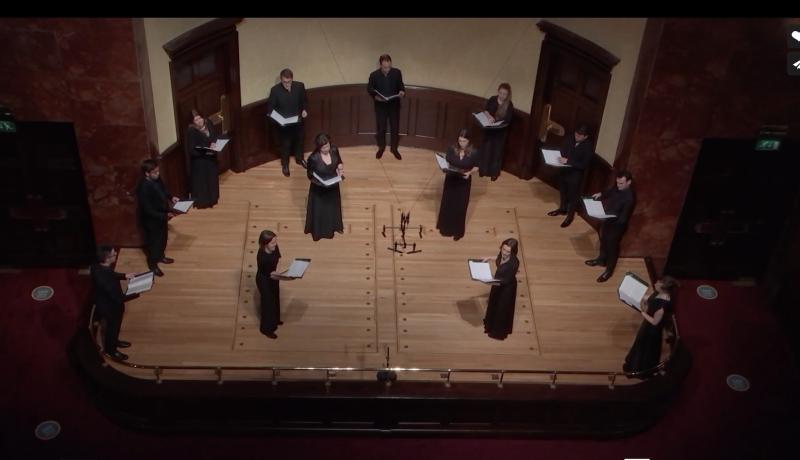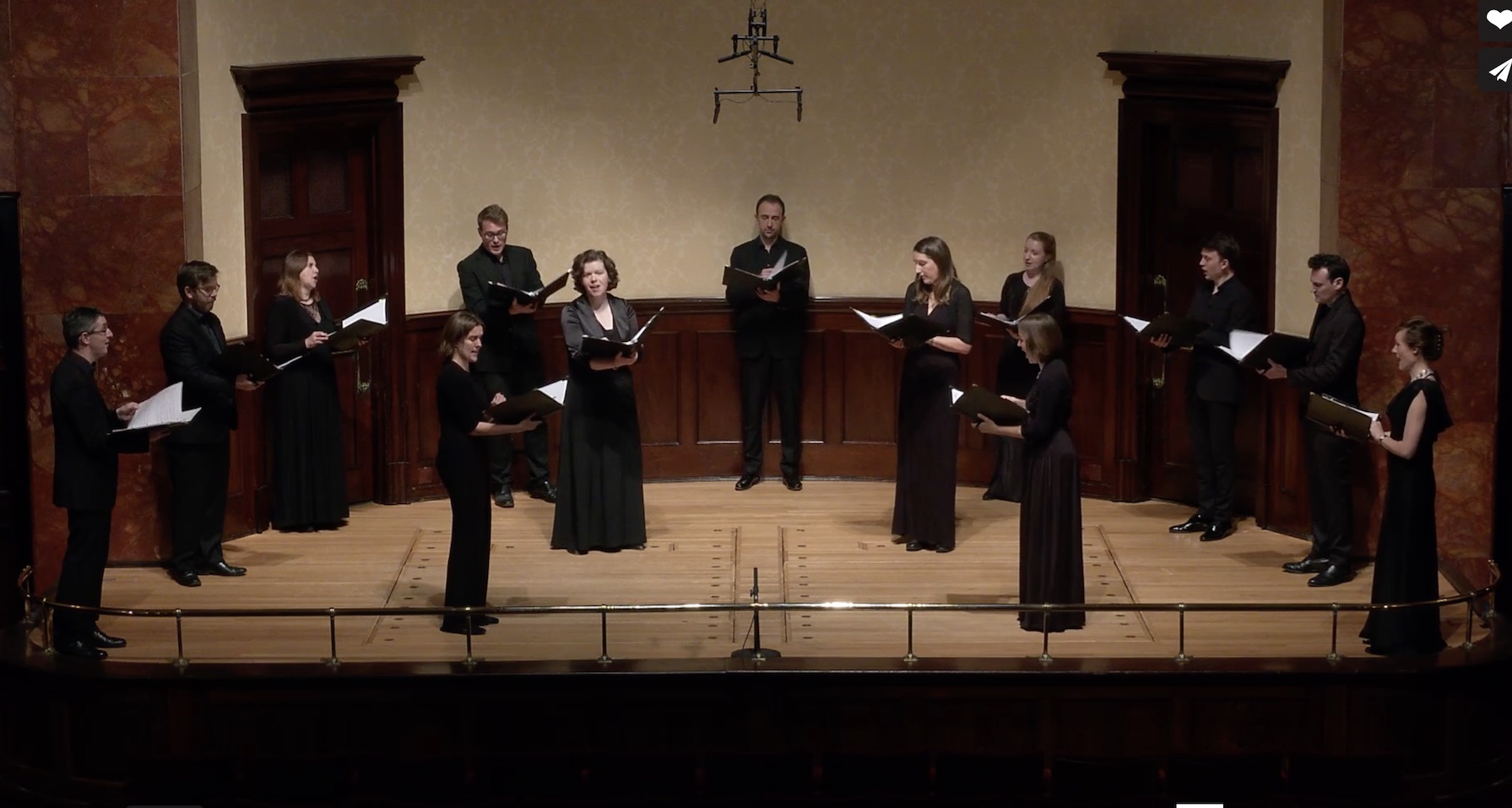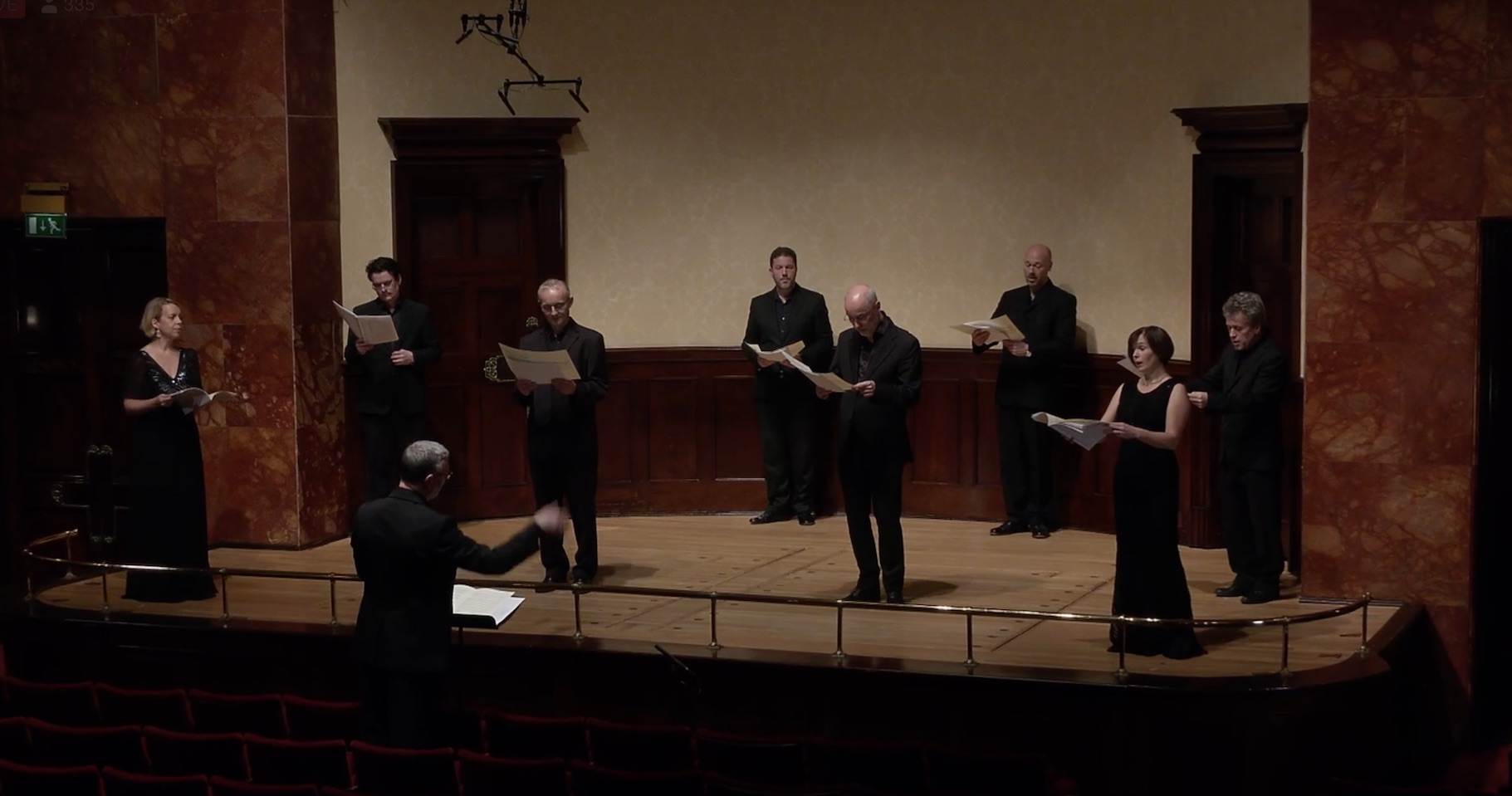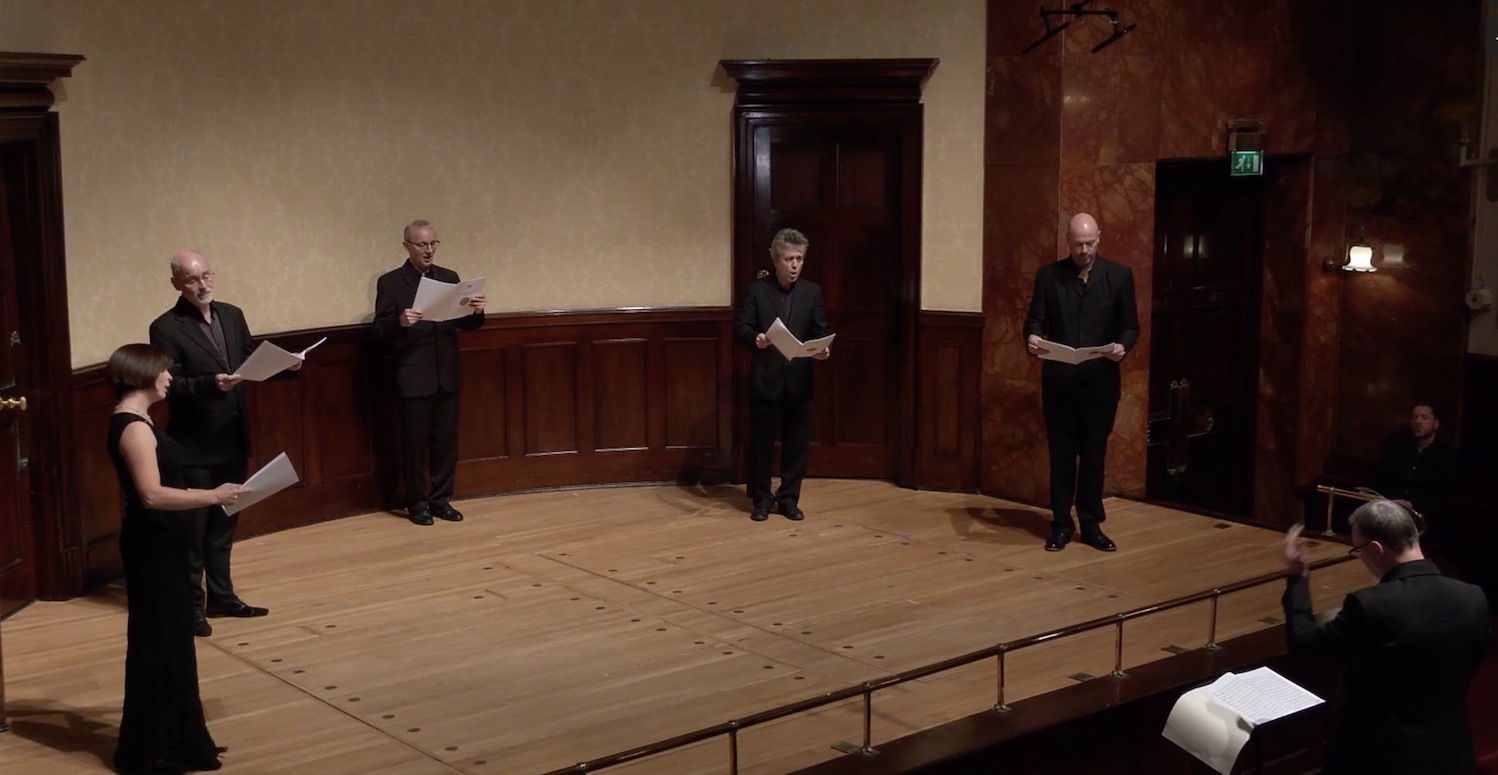Stile Antico, The Cardinall's Musick, Wigmore Hall online review – lightening our darkness | reviews, news & interviews
Stile Antico, The Cardinall's Musick, Wigmore Hall online review – lightening our darkness
Stile Antico, The Cardinall's Musick, Wigmore Hall online review – lightening our darkness
The rapt beauty of a Renaissance Christmas pierces the gloom

Suitably enough, this year’s musical Christmas arrived at the Wigmore not in a dazzle of joyful light and bedecked with winter greenery, but with a lonely band of singers facing the gloom of an unlit, empty hall as fear and confusion multiplied outside. In both of yesterday’s concerts, the closing events of the venue’s defiant and courageous autumn season, a cappella choral music from the Renaissance ushered in a festival more austere than ecstatic.
The 13 members of Stile Antico sang at lunchtime, and the eight-strong The Cardinall’s Musick – with director Andrew Carwood conducting – in the evening. Stile Antico presented a Spanish Nativity from the country’s Golden Age, revisiting the music from their seasonal recording last year. Its centrepiece was the 1602 Missa Beata Dei Genitrix by Alonso Lobo, preceded and intercut with rather folksier villancico numbers from the same period by other composers. They also enriched the Lobo mass with (for me) the only familiar piece in the programme: Victoria’s great motet O magnum mysterium: delicately shaped, fairly restrained, and so a bit less gut-punchingly spectacular than many versions sung by big forces in huge basilicas. Indeed, both of the day’s gigs deployed limited numbers with fine-focused precision. Both choirs, though, never lacked in sonic impact, and ensured that we didn’t miss a feeling of wall-of-sound polyphonic grandeur. They made the radiantly clear interaction of vocal parts a constant source of drama in itself. We heard more of the complex layering of line and texture that gives this repertoire such cumulative power.
 One regular pleasure of Christmas concerts is that, for once in the year, they allow hidebound divisions between art and vernacular music, sacred and secular styles, to dissolve. As interventions in Lobo’s gravely lovely Mass, 16th-century (or earlier) pieces such as the anonymous Ríu, ríu, chíu and Guerrero’s delectable A un niño llorando brought a flavour of the Spanish street and tavern Christmas into “church”. Mateo Flecha’s “ensalada” song El jubilate, for example, is a rhythmically nimble and witty mash-up that combines its singalong exuberance with episodes of rapt serenity. As they switchbacked between Mass and artfully madeover folk-tunes, Stile Antico [pictured above] showed off their versatility – in shading, phrasing and dynamics – as well as a crystalline purity of tone. They used the stage well, too (as did the evening’s performers), varying numbers and positions to enhance, and make audible, a sense of flexible architectural space. The ravishing cadences of Byrd’s Ecce Virgo Concipiet made for a spine-tingling encore full of finesse.
One regular pleasure of Christmas concerts is that, for once in the year, they allow hidebound divisions between art and vernacular music, sacred and secular styles, to dissolve. As interventions in Lobo’s gravely lovely Mass, 16th-century (or earlier) pieces such as the anonymous Ríu, ríu, chíu and Guerrero’s delectable A un niño llorando brought a flavour of the Spanish street and tavern Christmas into “church”. Mateo Flecha’s “ensalada” song El jubilate, for example, is a rhythmically nimble and witty mash-up that combines its singalong exuberance with episodes of rapt serenity. As they switchbacked between Mass and artfully madeover folk-tunes, Stile Antico [pictured above] showed off their versatility – in shading, phrasing and dynamics – as well as a crystalline purity of tone. They used the stage well, too (as did the evening’s performers), varying numbers and positions to enhance, and make audible, a sense of flexible architectural space. The ravishing cadences of Byrd’s Ecce Virgo Concipiet made for a spine-tingling encore full of finesse.
When, later, The Cardinall’s Musick took over the hall, the one conspicuous difference in their approach lay in Andrew Carwood’s presence as conductor. Stile Antico command such discipline and coherence in their sound that you could hardly claim that they ever (as it were) missed a beat. Pushed to define a distinction, you might say that Stile excel at a sort of collegiate consistency of tone whereas Carwood was able to steer his outfit [pictured below] through a slightly wider range of colours. And, whereas Stile gave us naked beauty without explanation, Carwood offered a useful, but not garrulous, commentary that sketched the background of his chosen pieces.
 So he described Palestrina’s own 1569 motet version of O magnum mysterium, which we heard first, as a sort of Lego kit that the composer later recombined into the Mass, using the same text, which followed. Five (at the end, six) of the Cardinall’s band sang the “ordinary” parts of the Mass while, in between, a couple of low voices contributed the “propers”: the plainsong verses specifically for Christmas morning. The result threw a more solemn, more liturgical mood over the performance, with Palestrina’s gorgeously interwoven lines still sounding more chaste than lush. At least, that is, until the Agnus Dei, when soprano melodies soar over deep harmonic seas beneath in one of those passages when sober Counter-Reformation black seems to burst out into quasi-operatic rainbow shades.
So he described Palestrina’s own 1569 motet version of O magnum mysterium, which we heard first, as a sort of Lego kit that the composer later recombined into the Mass, using the same text, which followed. Five (at the end, six) of the Cardinall’s band sang the “ordinary” parts of the Mass while, in between, a couple of low voices contributed the “propers”: the plainsong verses specifically for Christmas morning. The result threw a more solemn, more liturgical mood over the performance, with Palestrina’s gorgeously interwoven lines still sounding more chaste than lush. At least, that is, until the Agnus Dei, when soprano melodies soar over deep harmonic seas beneath in one of those passages when sober Counter-Reformation black seems to burst out into quasi-operatic rainbow shades.
This was singing of the highest order that demanded, and rewarded, rapt attention. Carwood described the music of Palestrina, who suffered from the plague and lost his wife to it, as “about bringing heaven to earth”. Here it was hard to disagree. After a pair of small choral gems by Schütz, our final visit to polyphonic heaven came via a setting of the Magnificat (1622) by the Hamburg organist-composer Hieronymus Praetorius – unrelated, it seems, to the better-known Michael. Interspersed with the Magnificat’s texts (as would have been the custom at the time), the choir added harmonised versions of two traditional carols: Josef lieber, Josef mein (set by Leonhard Schröter), and the ubiquitous In dulci jubilo – two verses set by a certain Walter, and two arranged by a rather more familiar figure: JS Bach.
 Expressive, and responsive, singing ensured that carols and liturgical music blended seamlessly. If, for the most part, yesterday’s Wigmore Christmas made for a muted and contemplative festival, here at last a taste of almost-Venetian sonic luxury and lavishness prevailed. The modest forces of The Cardinall’s Musick conjured not so much a mighty sound as an endlessly nuanced and variegated one. We even had delicious touches of Christmassy descant to add a sprig of holly to the cake. Once more, the Wigmore gave us something to sing about in the midst of wretched times.
Expressive, and responsive, singing ensured that carols and liturgical music blended seamlessly. If, for the most part, yesterday’s Wigmore Christmas made for a muted and contemplative festival, here at last a taste of almost-Venetian sonic luxury and lavishness prevailed. The modest forces of The Cardinall’s Musick conjured not so much a mighty sound as an endlessly nuanced and variegated one. We even had delicious touches of Christmassy descant to add a sprig of holly to the cake. Once more, the Wigmore gave us something to sing about in the midst of wretched times.
rating
Explore topics
Share this article
The future of Arts Journalism
You can stop theartsdesk.com closing!
We urgently need financing to survive. Our fundraising drive has thus far raised £49,000 but we need to reach £100,000 or we will be forced to close. Please contribute here: https://gofund.me/c3f6033d
And if you can forward this information to anyone who might assist, we’d be grateful.

Subscribe to theartsdesk.com
Thank you for continuing to read our work on theartsdesk.com. For unlimited access to every article in its entirety, including our archive of more than 15,000 pieces, we're asking for £5 per month or £40 per year. We feel it's a very good deal, and hope you do too.
To take a subscription now simply click here.
And if you're looking for that extra gift for a friend or family member, why not treat them to a theartsdesk.com gift subscription?
more Classical music
 First Person: clarinettist Oliver Pashley on the new horizons of The Hermes Experiment's latest album
Compositions by members of this unusual quartet feature for the first time
First Person: clarinettist Oliver Pashley on the new horizons of The Hermes Experiment's latest album
Compositions by members of this unusual quartet feature for the first time
 Gesualdo Passione, Les Arts Florissants, Amala Dior Company, Barbican review - inspired collaboration excavates the music's humanity
At times it was like watching an anarchic religious procession
Gesualdo Passione, Les Arts Florissants, Amala Dior Company, Barbican review - inspired collaboration excavates the music's humanity
At times it was like watching an anarchic religious procession
 Classical CDs: Camels, concrete and cabaret
An influential American composer's 90th birthday box, plus British piano concertos and a father-and-son duo
Classical CDs: Camels, concrete and cabaret
An influential American composer's 90th birthday box, plus British piano concertos and a father-and-son duo
 Cockerham, Manchester Camerata, Sheen, Martin Harris Centre, Manchester review - re-enacting the dawn of modernism
Two UK premieres added to three miniatures from a seminal event of January 1914
Cockerham, Manchester Camerata, Sheen, Martin Harris Centre, Manchester review - re-enacting the dawn of modernism
Two UK premieres added to three miniatures from a seminal event of January 1914
 Kempf, Brno Philharmonic, Davies, Bridgewater Hall, Manchester review - European tradition meets American jazz
Bouncing Czechs enjoy their Gershwin and Brubeck alongside Janáček and Dvořák
Kempf, Brno Philharmonic, Davies, Bridgewater Hall, Manchester review - European tradition meets American jazz
Bouncing Czechs enjoy their Gershwin and Brubeck alongside Janáček and Dvořák
 Solomon, OAE, Butt, QEH review - daft Biblical whitewashing with great choruses
Even a top soprano and mezzo can’t make this Handel paean wholly convincing
Solomon, OAE, Butt, QEH review - daft Biblical whitewashing with great choruses
Even a top soprano and mezzo can’t make this Handel paean wholly convincing
 Two-Piano Gala, Kings Place review - shining constellations
London Piano Festival curators and illustrious friends entertain and enlighten
Two-Piano Gala, Kings Place review - shining constellations
London Piano Festival curators and illustrious friends entertain and enlighten
 Echo Vocal Ensemble, Latto, Union Chapel review - eclectic choral programme garlanded with dance
Beautiful singing at the heart of an imaginative and stylistically varied concert
Echo Vocal Ensemble, Latto, Union Chapel review - eclectic choral programme garlanded with dance
Beautiful singing at the heart of an imaginative and stylistically varied concert
 Scott, Irish Baroque Orchestra, Whelan, RIAM, Dublin review - towards a Mozart masterpiece
Characteristic joy and enlightenment from this team, but a valveless horn brings problems
Scott, Irish Baroque Orchestra, Whelan, RIAM, Dublin review - towards a Mozart masterpiece
Characteristic joy and enlightenment from this team, but a valveless horn brings problems
 Classical CDs: Voice flutes, flugelhorns and froth
Baroque sonatas, English orchestral music and an emotionally-charged vocal recital
Classical CDs: Voice flutes, flugelhorns and froth
Baroque sonatas, English orchestral music and an emotionally-charged vocal recital
 Kanneh-Mason, Britten Sinfonia, Shave, Milton Court - a grin and a big beaming smile
A pair of striking contemporary pieces alongside two old favourites
Kanneh-Mason, Britten Sinfonia, Shave, Milton Court - a grin and a big beaming smile
A pair of striking contemporary pieces alongside two old favourites

Add comment